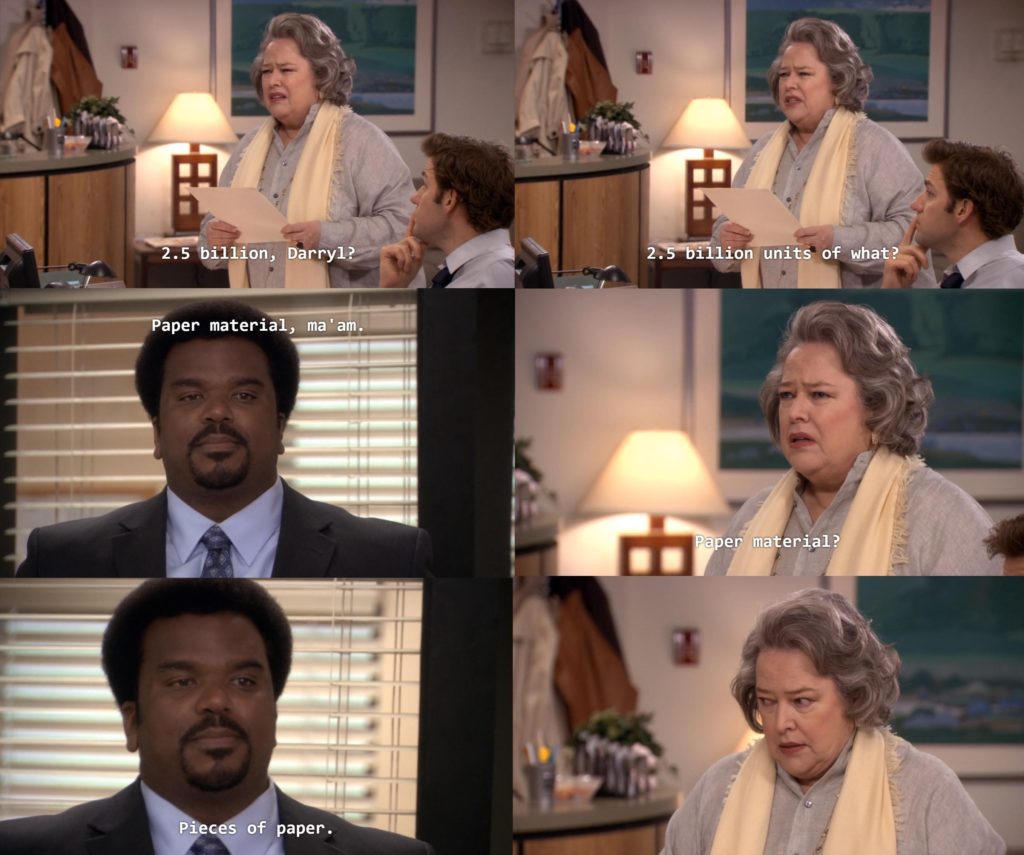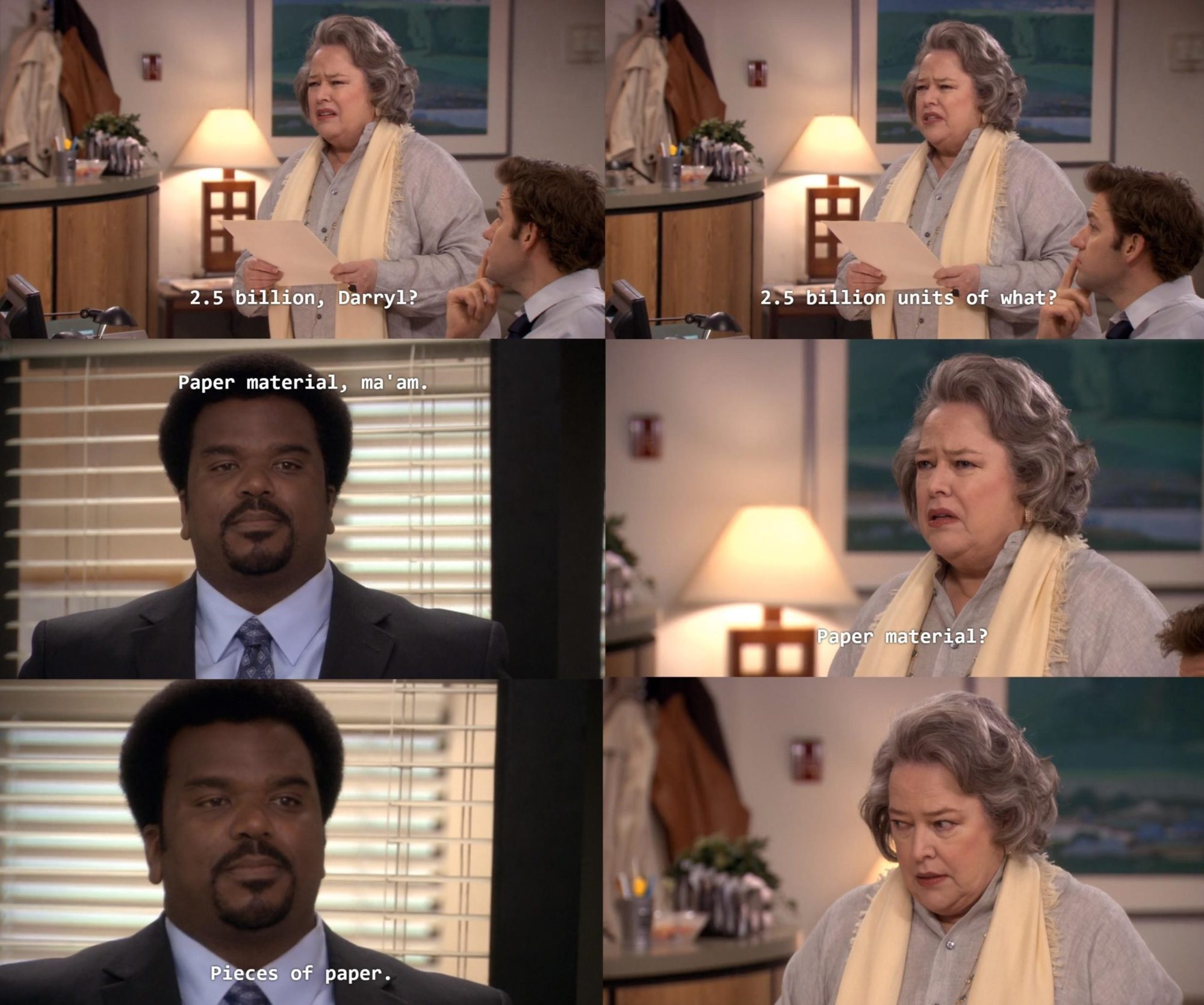During my treadmill run on Sunday afternoon, I watched a few episodes of The Office. Between scenes, I saw a commercial that boldly claimed that Amazon has given 5.4 million items to victims of natural disasters.
It reminded me of a scene from an episode of The Office in which CEO Jo Bennett asks Darryl Philbin about a line on his resume:
Jo: Coordinated and implemented receipt, storage, and delivery of over 2.5 billion units of inventory. 2.5 billion, Darryl? 2.5 billion units of what?
Darryl: Paper material, ma’am.
Jo: Paper material?
Darryl: [softly] Pieces of paper.
The Office, “Search Committee”

5.4 Million Items is Just a (Kind of Large) Number
The full text of the Amazon commercial is as follows:
At Amazon, we don’t just think big, we do big.
We’ve given more than 5.4 million items to victims of natural disasters.
We’ve donated over 7.1 million items for Covid-19 relief.
We’ve delivered over 12 million meals to people in need.
And we’re not stopping there.
I’m not an expert on humanitarian aid– but something about measuring your impact by the number of items given feels random at best.
It’s no secret that humans are exceptionally bad at comprehending large numbers. So advertising your disaster response in the number of items given is difficult for consumers to understand– and likely confuses them. It would be easier to understand (and more helpful to know) the ratio of items that Amazon has delivered to survivors of natural disasters to total items that Amazon delivers each year.
If Amazon delivered 3.5 billion packages in 2019 (and it delivered many more than that in 2020), it’s donation of 5.4 million items is just 0.15 percent of total packages delivered in 2019.
Measuring your impact in numbers of items or meals donated is like measuring your level of fitness by the number of steps that you take in a day– it’s a meaningless number with no relationship to reality. And I say that as a former Fitbit user.
I’ve been skeptical of Amazon’s philanthropic work before. Throughout the pandemic, Amazon has aired a similarly vague commercial about their education initiatives.
In June 2020, Amazon announced a meager donation of $10 million to racial justice and equity organizations. That’s 0.0025 percent of Amazon’s 2020 revenue.
Against that backdrop of meaningless action by Amazon, let’s explore their disaster response philanthropy.
Amazon’s Disaster Response Philanthropy is (Pretty Much) Disastrous
While the commercial I saw was likely aired to coincide with the deadly cold and storms that have ravaged Texas, Amazon’s disaster response work goes back at least several years. An Oct. 2019 article on aboutamazon.com titled, “Amazon’s disaster relief doesn’t end with donations” describes Amazon’s previous work to respond to natural disasters. To be clear, the article is written by “Amazon Staff”– it’s a public relations piece.
There are undeniable bright spots to their work. Amazon has five diverse, dedicated staff to manage their disaster response efforts. The company collaborates with nonprofits to deliver only the items requested by on-the-ground partners. Their “working backwards” process is used, “to ensure a project begins with the customer in mind first”– it’s reminiscent of human-centered design thinking used to best serve vulnerable or marginalized communities.
Amazon touts the utility of their logistics expertise in responding to natural disasters. The video below describes how Amazon uses AWS (Amazon Web Services) to prepare for and respond to natural disasters. There’s obviously a lot of potential for Amazon to harness their capabilities for positive impact.
On the other hand, Amazon only has five staff to manage their disaster response efforts– of one million total staff. That’s 0.0005 percent of their staff.
From the video below, it seems that many of the “relief items” that Amazon delivers to survivors of natural disasters are actually donated by Amazon users– and Amazon’s role is to deliver them to areas of need.
Of course, responding to disasters is crucial– but wouldn’t it be better to work to mitigate and prevent them in the first place?
Additionally, Amazon’s disaster response is just that– it’s a response. Rather than working to mitigate the risk of natural disasters that are increasingly not-so-natural, Amazon is responding to them. They’re missing the mitigation stage of the disaster life cycle; their commitment to renewable energy and sustainability, which could help to mitigate climate change, is complicated at best. Of course, responding to disasters is crucial– but wouldn’t it be better to work to mitigate and prevent them in the first place?
The Big Picture: Does Amazon Do More Harm Than it Alleviates?
Beyond the enormous environmental impact of its cloud services, Amazon has a laundry list of other social and environmental issues that counteract its philanthropic work– and perhaps incentivized that philanthropy in the first place.
Amazon has been criticized (and sued) for its lack of health and safety protections for warehouse workers during the Covid-19 pandemic. Many of its workers are enrolled in the Supplemental Nutrition Assistance Program (SNAP). There are concerns over Amazon’s treatment of BIPOC employees.
What if rather than making performative and reactive donations to survivors of natural disasters, Amazon committed to not contribute to social and environmental issues in the first place?
I’m sure it wasn’t intentional that Amazon aired their disaster response commercial on Comedy Central during episodes of a show about one of the least efficient (albeit fictional) companies of all time.
But there’s something comedic, if not completely ridiculous, about measuring impact in such vague terms.
Jo wasn’t fooled by Darryl’s use of large numbers– and Amazon, I’m not fooled by you either. As consumers (and as Amazon Prime users), we can expect more from one of the most profitable companies in the world.
- College Football, Ariana Grande, and Water - September 3, 2023
- Livestock and Land Use: How Are We Feeding The Planet? Impactfull April 2022 - April 19, 2022
- What Does Voluntourism Look Like? A Case Study in a Cambodian Orphanage - March 28, 2022
